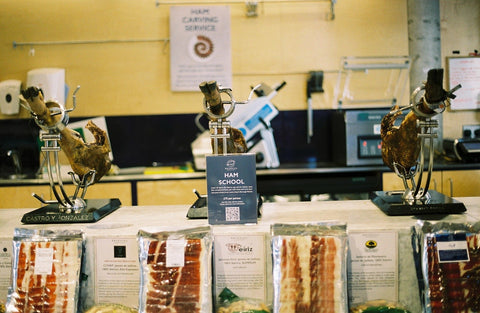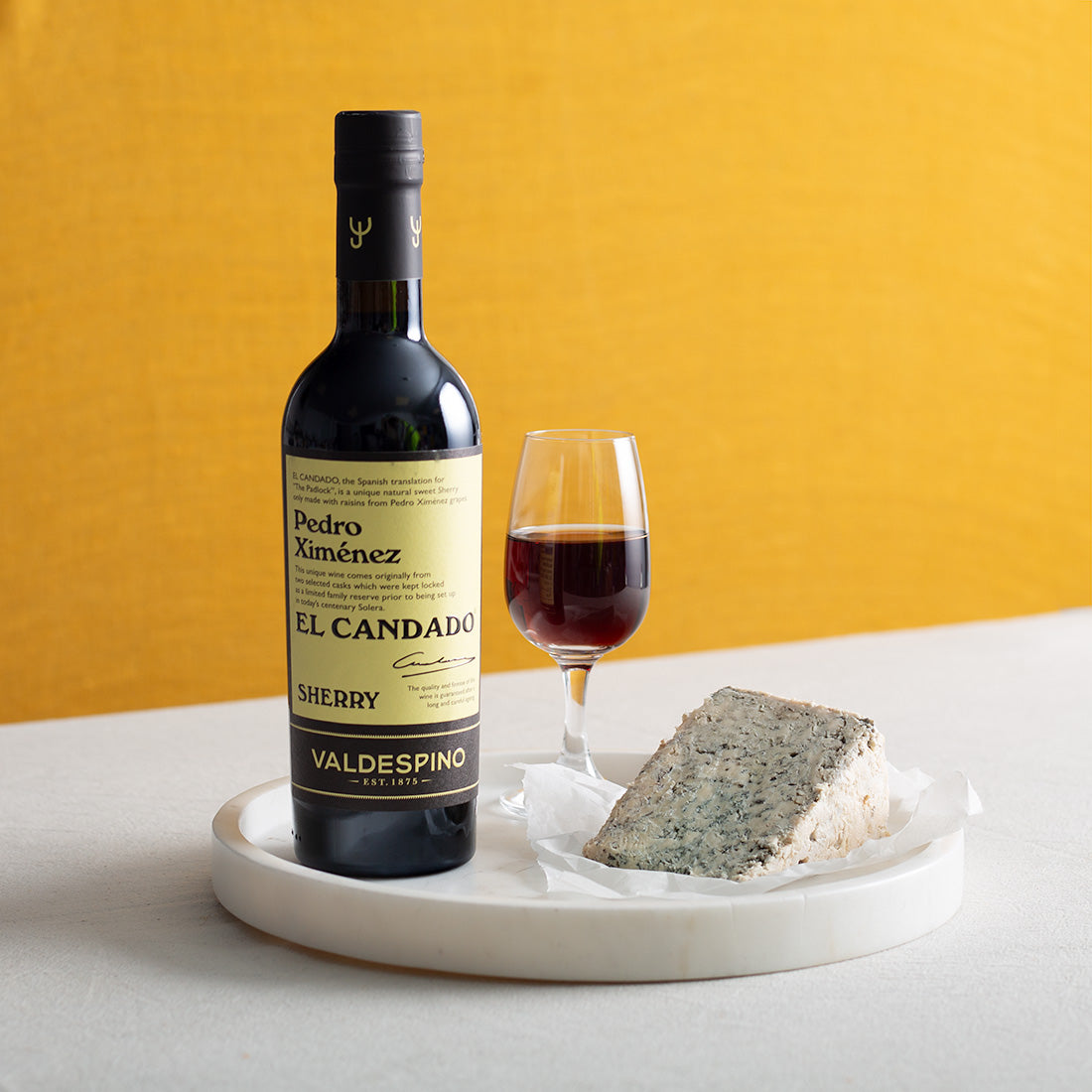The Insider's Guide to Ibérico Ham
King of ham, Brindisa's own James Robinson shares why Ibérico is the most highly prized air-dried ham and what you need to know when shopping and eating this delicious Spanish ham!
by James Robinson | Head of Product Training at Brindisa
What is so special about Ibérico ham?
Ibérico is the most highly prized air-dried ham, from animals of an ancient breed of semi-wild black Ibérico pig. The Ibérico pig has characteristically long slender legs, a sensitive snout to forage with, and dark skin to help protect it in the sun. The ham it produces is popularly known as pata negra, referring to the black hoof which stays on the slim leg throughout the curing process. and makes it look very different from other hams.
How to buy Ibérico ham
Buying Ibérico ham can be confusing, particularly if you are not familiar with the descriptions used; the one thing everyone knows is that it is expensive, but how much should it cost?
It was in an attempt to bring some clarity to the consumer that the Spanish government introduced a law in April, 2014 to clarify and standardise the descriptions of different types of Iberico ham.
The four grades of Ibérico Ham
Simply put, the legislation sets out four different grades of Ibérico ham. It is based on the pigs' diet and the purity of breed. By simply looking at the official description the consumer can make an educated choice about the quality, and hence the price, of their ham.
The four grades that were created are indicated on any Ibérico ham or paleta (cured shoulder) on the bone by a tag (precinto)around the ankle, or on any boneless Ibérico ham, paleta or cured loin by a tag attached to the sealed piece. These tags are essentially legal indicators of how the Ibérico pigs were raised and fattened and what the minimum curing time of the ham was.

Black Tag Iberico
The top grade of Ibérico ham goes by the full description of “Jamon de bellota, 100% Ibérico, ‘pata negra’”. Jamon de bellota signifies that the Ibérico pig fattened up on acorns (bellotas) on the autumn “montanera” when the animals are put to forage on the dehesa, the oak covered savannah that makes up several million hectares of the south west of the Iberian peninsula. 100% Ibérico means that it is a pure-bred animal, and pata Negra is a term that used to be used generically for any Ibérico ham, but now can only be used to describe this top grade of ham. Hams and paletas will have a black tag around the ankle, issued by the relevant regional body.

Red Tag Ibérico
The second grade is described as “Jamon de bellota, 50/75% Ibérico”, which means that the animal has undergone the montanera, but that either one parent, or one grandparent was of non-Ibérico origin. When cross-breeding does occur the mother will always be 100% Iberico and the boar must be of the Duroc breed. This cross-breeding has two functions, firstly to prevent continual inbreeding, never a good idea, and also, to breed animals which will have more progeny and, frequently, larger back legs. Hams and paletas from these animals will have a red tag around the ankle.
These are the only grades of Ibérico ham made from animals that have fattened up on acorns and they account for about 20% of all Ibérico hams.

Green Tag Iberico
The third grade is called “Jamon de cebo de campo, 50/75/100% Ibérico” which indicates that the animal lived outdoors but fattened up on cereals and natural feed before slaughter. This means that the quality of the meat will excellent, but lacking the deep, sweet intensity of the acorn-fed hams. This accounts for a further 20% of Ibérico hams.

White Tag Iberico
The fourth grade is the one that tends to cause confusion; “Jamon de cebo, 50/75/100% Ibérico” indicates, in essence that the ham will almost certainly have been intensively reared. Where the minimum space required per animal for the top three grades during the fattening period is 1 hectare (100m²), the minimum required for this grade is 2m²! Simply put, this is the grade that can be made from intensively reared animals, and thus significantly more cheaply than the other grades of Ibérico ham. This grade accounts for 60% of all Ibérico ham production.
Why the Ibérico grades are so important
This information can help you understand the welfare standards of the pig rearing and the pricing of Ibérico hams. However, it also shows something more fundamental; it offers you the opportunity to make a choice about being part of a continuum that extends back 3,000 years. The dehesa is a unique environment that has been shaped by the indigenous animals of the region, and has shaped them too. This huge area has more endangered species of bird and animal life than anywhere else in Western Europe due to this slow evolution. By choosing a ham made from an animal that has followed innumerable generations of its ancestors living and feeding on the dehesa, you are helping to maintain an ecosystem whose environmental value is immense.
The bellota and cebo de campo animals have a symbolic relationship with their environment, and one which does wonders for the quality of meat. The jamon de cebo is essentially a commercial construct and it is a means by which the larger, more industrial ham producers can produce and sell a premium priced product under the cloak of respectability created by the origins of the higher grades of ham. This is not to say that there may not be some good jamon de cebo Ibérico hams, but that those produced to the minimum requirements are unlikely to be among them.
Making an ethical choice
When buying Ibérico ham, you can certainly make an ethical choice. You can choose to buy a product made from a free ranging animal that forages on the foods that they have evolved to consume over many thousands of years, and is arguably the most magnificent ham in the world, or whether you want a very decent ham at a cheaper price whose provenance does not concern you.
Caveat emptor!
Brindisa Ibérico Ham
by Monika Linton | Founder of Brindisa
When we first started bringing in de bellota Ibérico ham, before there was any real acceptance or understanding of it in Britain, I gave a wonderful ham to chef Simon Hopkinson, then at Bibendum, who was very excited by the arrival of this delicacy. His instincts were right; he simply sliced it and sent it out to diners, but the plates came back with the fat trimmed off and customers wanting to know why it was there. I was duly called over to the restaurant to confirm that the ratio of fat to lean was perfectly normal and exactly as it should be.
It was an absurd misunderstanding of a fine product that seemed so characteristic of modern meat production and consumption, which has all fat marked out by many people as almost criminal. Simon did, however, have one customer who genuinely appreciated and understood fine fat; the late great artist Francis Bacon. Simon saved up all of the trimmings that the other customers had eschewed and offered them to him to top-up his own slices of the ham, and they were enjoyed with great gusto.
Why Monika always wanted to sell Ibérico ham

As incompatible as these semi-industrial hams felt alongside the farm-made Churra sheep's milk cheeses and other artisan produce that we were bringing in from Spain, I badly wanted to sell Spanish ham. And although those early examples from Large White pigs crossed with Durocs may not have been as specialist as those we can source today, they were still a delightful, novel experience for most British people; a rich red colour, with a more pronounced flavour than their Italian equivalents.
Once the market opened up, we were able to become properly selective and begin forging real relationships with favourite producers. Ultimately there is no substitute for this. Only through getting to know the farming, husbandry and curing processes can you understand what makes a truly great ham.
Ibérico ham at Borough Market
The Brindisa deli in Borough Market in London has a dedicated ham counter where the Brindisa ham carvers sell freshly carved high quality Ibérico and Serrano ham.
You can find out more about the Borough Market deli here.

BUY THE FINEST IBERICO HAM FROM BRINDISA ONLINE
You can see the full collection of incredible freshly carved Iberico ham products that Brindisa sells here.
 New in: Señorio Acorn-Fed Ibérico Ham Kit
New in: Señorio Acorn-Fed Ibérico Ham Kit 100% Iberico Hand-Carved Ham
100% Iberico Hand-Carved Ham Cooking Chorizo
Cooking Chorizo Freshly Sliced Charcuterie
Freshly Sliced Charcuterie FESTIVE PICK: GRANIZO WITH TRUFFLE
FESTIVE PICK: GRANIZO WITH TRUFFLE ARTISAN CHEESE BOX
ARTISAN CHEESE BOX Tinned Fish
Tinned Fish OLIVES, NUTS AND SNACKS
OLIVES, NUTS AND SNACKS OLIVE OIL & VINEGAR
OLIVE OIL & VINEGAR SAUCES & GAZPACHO
SAUCES & GAZPACHO GIFT BOXES AND HAMPERS
GIFT BOXES AND HAMPERS New in: iconic Perelló decorations
New in: iconic Perelló decorations Sparkling Wine
Sparkling Wine Sherry
Sherry BEST SELLERS
BEST SELLERS New in: Perelló Olive Oil
New in: Perelló Olive Oil









Comments
You have a wonderful explanation about the different types of Iberico hams – especially their animal welfare. Is there anything equivalent about Serano hams?